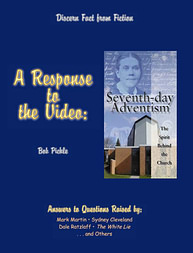|
A Response to the Video:
Seventh-day Adventism, the Spirit Behind the Church
by Bob Pickle
Answers to Questions Raised by:
Mark Martin, Sydney Cleveland
Dale Ratzlaff, The White Lie
. . . and Others
Discern Fact from Fiction
Other Doctrines; the Jehovah's Witnesses
< Prev T. of C. ... 86-88 89 90-91 92-93 94 95-96 97 98-99 100 ... Next >
| #94: "Early prominent Adventists, including
James White and Uriah Smith, denied the deity of Jesus
Christ, as do the Jehovah's Witnesses."—Leslie Martin. |
#94: Uriah Smith and James White denied
the deity of Christ. This is simply not true. The documentation
package under
"Point 48" and "Point 48a" gives no evidence to support such a claim. To the contrary, it
cites James White as writing in 1877 that "ultra
Unitarianism that makes Christ inferior to the Father is worse. Did God say to an inferior,
'Let us make man in our image?' "
James White repeatedly called Jesus "the divine Son of God" (Bible
Hygiene, pp. 192, 203; The Law and the Gospel, p. 14;
Life
Incidents, p. 357; The Redeemer and Redeemed, p. 46). Uriah
Smith called him "God's divine Son" (The Biblical Institute, p. 140).
Smith emphatically stated that Christ is not a created being, and opposed such a teaching
(Daniel and the Revelation, pp. 400, 430; Looking
Unto Jesus, pp. 3-4, 10, 12, 18, 20-21).
White, Smith, and others reacted against certain speculations of their time regarding
the Godhead. Their reactions are assumed to be a denial
of belief in what the Bible teaches about the Trinity, making this charge in the video all too
common. But such an assumption is unwarranted
in light of three popular speculations about the Godhead that they reacted against.
A catechism from one church and a book from another taught the
following: God is composed of three persons and is "without body or
parts," but the second person definitely has a body! This view was criticized in the March 7,
1854, issue of the Review and Herald, page 50.
Early Seventh-day Adventists advocated taking the Bible literally unless there was an
obvious symbol used. They
saw such views of the
Godhead as not doing this, since the Bible describes God as having a [p. 68] form and sitting on His
throne in Heaven (e.g. Rev. 4:2, 3).
Just as they rejected views that spiritualized away the literalness of the second coming,
so also they rejected views that spiritualized away
the personality of God. - Some views of the Trinity did not make the Father and Christ to
be separate persons. This can readily be concluded from the documentation
package's "Point 48." Joseph Bates is quoted as writing:
"Respecting the trinity, I concluded that it was an impossibility
for me to believe that the Lord Jesus Christ, the Son of the Father,
was also the Almighty God, the Father, one and the same being."
The orthodox view of the Trinity includes an aspect that speculates
regarding when Christ was begotten. Most believers are unaware of
this aspect called the "processions." It teaches that the Son proceeded forth from the Father,
and the Holy Spirit proceeded forth from both the
Father and the Son. Yet, since God is outside of time, there never was a time when one of
the three did not exist. So Jesus was begotten and
proceeded forth, but that's not to say that He hasn't always been.
Pope John Paul II's views, found in Hogan and LeVoir's Faith for Today
(complete with Imprimatur), describes this position pretty well.
John Paul believes that the Father's self-concept, unlike our self-concept, is real. In God's
"consciousness" was "an identical image of Himself,"
and that is how the Son was begotten. "The consciousness of the Father and the Son contains
an inner reflection and image of Their act of Love,"
and that is how the Holy Spirit proceeded forth (pp. 12-14).
A 1933 English translation of a standard Dutch catechism, published in India,
describes the processions in essentially the same way (J. F.
De Groot, Catholic Teaching, pp. 99, 100).
A priest this writer heard lecture on the right to life included material in his talk about
the Trinity. He said that when the Father and Son
looked at each other, they had love for each other, and they sighed, and that was "the Holy
Sigh."
And yet, though the Son and the Spirit came forth, They always have been, since God
and the processions are outside of time (Hogan and
Levoir, p. 14). Sounds a bit contradictory? These early Seventh-day Adventists thought
so.
They apparently had no problem with the general idea of the processions, judging from
what little they wrote on that topic, but they just
couldn't be dogmatic about both God and the processions being outside of time. So can we
with a clear conscience call men cultists and non-Christians who wanted to take the Bible just
as it reads and not speculate like this?

|

|
Like this book?
Save your printer and your ink!
Buy the entire 160-page book for
just
$9.95 + S/H.
Automatic discounts start
at 5 copies.
|
|
|
< Prev T. of C. ... 86-88 89 90-91 92-93 94 95-96 97 98-99 100 ... Next >
|



